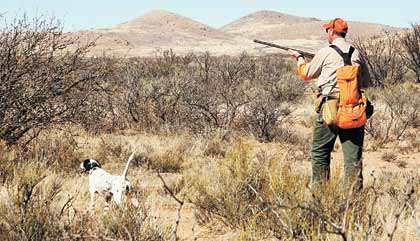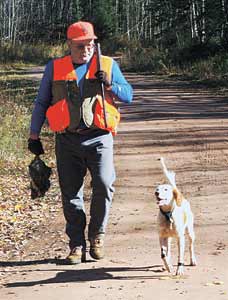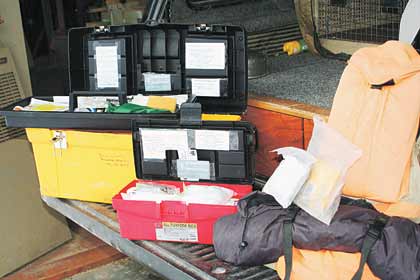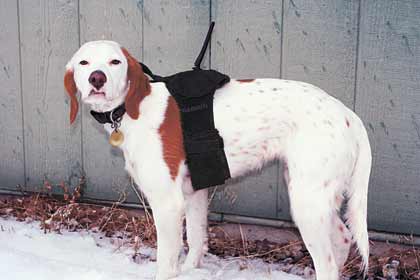How to keep your dog from doing something stupid.
By Dave Carty
 It always pays to be prudent when approaching a point....and if something doesn't feel right, be extra alert. Photo by Dave Carty. |
For someone who has never served in the military, I am perhaps overly fond of military analogies, but I've always looked at my dogs as front line troops and my role as commanding officer in charge of maneuvers, safety, and too often, medical evacuations. Age has not brought me a gentle acceptance of the potential for canine train wrecks; I've seen too many of them. But if I haven't gained a measure of tranquility, at least I've learned what to avoid.
Case in point: Quite a few years ago, a buddy and I pulled off a busy highway to hunt a local ranch. He was an experienced hunter and veteran field trialer, but for some inexplicable reason he decided to let his Brittany out the back of my rig moments after a pickup crested the hill above us. As I watched, horrified, the dog darted onto the road at the same instant the truck roared by. The truck, whose driver almost certainly never saw it, missed the dog by scant inches.
Stupid moves like that--both his and mine, in that case--often lead to medical emergencies, and before I discuss how to prevent them, let's talk for a moment about how to handle them once they occur. Taking care of medical problems in the field can be summed up in the old Boy Scout motto: Be prepared. That means having at least one first aid kit handy at all times. I have three.
The first is my home kit, which is the size of a large tackle box and contains enough gear to medicate, stitch up, and alleviate most of the medical problems and minor emergencies I've run into over the years--way more stuff than I'll probably ever use, but comforting to have around. The next is a much smaller tackle box that lives in the back of my truck. In it I've got sterile bandages, eye wash, athletic tape, vet wrap--whatever I think I'll need to get the dog from my truck to either my home or a vet's office.
But the most critical first aid kit is the one I always carry with me in my vest. That kit has been winnowed down over the years, until most everything in it will fit in the small back cargo pocket above the game pouch. A zip-lock bag carries hemostats (for removing porcupine quills and thorns), tweezers (eye problems); a couple rolls of white athletic tape, an additional roll of vet wrap, and a package of three- by four-inch sterile bandages. I also carry at least one roll of black electrician's tape in another pocket, which comes in handy for wrapping all kinds of things, from bandages to dog booties.
This isn't nearly as comprehensive a kit as some vets recommend (and sell), and I have no arguments with those who want to carry more elaborate kits in the field. But 35 years of bird hunting has convinced me that the best thing I can do for an injured dog is to stop the bleeding and get it back to my primary first aid kit at home and/or to a vet as quickly as possible.
On that subject, I've given some thought to devising some type of carrier that I can use to carry an injured dog out of the field, perhaps something along the lines of the slings some women use to carry infants. Never assume that carrying out a dog is only a remote possibility; I've been forced to do so several times, the last a couple seasons ago, during a hunt in northern Wisconsin.
 John Meyer, the author's hunting buddy, walking a road in grouse country. When hunting near roads or releasing a dog from a truck near a road, it's critical to keep an eye on the dog and leash it if traffic approaches. Photo by Dave Carty. |
That's when one of my setters, Scarlet, ran full-tilt into a pointed stick. The stick peeled off most of the skin on her front leg and then sliced completely through her back thigh, just under the skin. She was bleeding so profusely that it took me a minute to figure out what had happened to her. I patched her up with athletic tape as best I could and carried her back. There, my buddy John, who just so happens to be a medical doctor, gave her a thorough examination.
The whole episode was like a weird flashback. Scarlet had run into another pointed stick just a couple months earlier, lacerating her other thigh. Then, as now, John had been along, and when we got her back home, he walked me through a complete ER procedure: debriding the laceration, sterilizing it, and stapling it back together. She healed without a trace.
But this was a considerably more serious wound, and when John advised against our trying to stitch her up ourselves, I took his advice to heart and made the decision to take her to a vet. It was an expensive move, but the right one.
I usually keep the numbers of local vets taped to the inside of my first aid kit, but for some reason had neglected to do so on that trip. It wasn't a big problem, as it turned out, but it could have been. Keeping contact information for local vets handy is one of the single best things you can do to prevent an emergency from becoming a crisis.
Misplacing my phone numbers probably wasn't the smartest thing I've ever done, but for what it's worth, my dogs have made plenty of bonehead moves without any help from me. Often, those moves involve their being somewhere they shouldn't be. My main job as C.O. is to try to prevent them from wandering into enemy territory.
It hasn't always been easy. Scarlet, whom I'm beginning to think has some sort of death wish, has been known to run to the very edge of a cliff on a chukar hunt, skid to a stop, and peer nonchalantly over the edge, her front toes hooked over the lip of the precipice as though gauging the distance to the ground. The first high-altitude hunt where she demonstrated her complete disregard for common sense was also her last: I decided that from then on I'd limit my hunting to the bottom of cliffs whenever possible.
It takes time to recognize the risks inherent in any new area. In Arizona, bird hunters look for javelinas and cholla cactus; in Montana everyone knows where the snakes are. Since those areas are usually apart from the prairies and wheatfields where the sharptails and Huns live, it's a no brainer--I keep my dogs away from them.
But prairies have their own hazards. A half dozen years ago, Scarlet and Powder, my Brittany, locked up at the base of a juniper tree. Halfway there, as I scurried up to shoot, I knew something wasn't r
ight; Huns virtually never covey below the thick cover of junipers. I was about to call them off when the two broke and dove into the middle of a huge porcupine.
Once again, my doctor buddy John was there, and between the two of us, we managed to pull dozens of quills from the face, throat and tongues of both animals. They were fine. But there's a moral to this story: If something about the way your dogs are acting doesn't feel quite right, pay attention! Better to call your dog off a covey than to have it jump a snake or a porcupine.
 The author's three first aid kits. Note the veterinarian phone numbers taped to the inside of the lids. Photo by Dave Carty. |
Medical emergencies are something I've learned to deal with over the years, but one situation still terrifies me: losing one of my dogs. The year before last I lost Scarlet (who else?) in Oregon. I don't know what I would have done if she hadn't found her way back to my truck.
Recently, though, I was given an Astro 220, the new canine GPS unit made by Garmin. I'll write more about my experiences with the Astro in a future issue, but I think it's safe to say that these GPS units will revolutionize the way we keep track of our dogs in the same way they revolutionized outdoor navigation.
Why do you need a tracking unit? Some of you won't. Those with close- ranging pointers or flushers really don't need one. But for those of you who, like me, spend a lot of time hunting in wide-open country, or who hunt in thick cover with big-running dogs, the Astro 220 offers peace of mind that a bell or beeper can't touch.
They're not without problems. The antennae juts from the receiving unit on the dog's back or neck at an abrupt 90-degree angle, so is highly vulnerable to breaking off. My dogs have bent, mangled and broken several of my unit's five-inch antennas by running under low-slung strands of barbed wire. I've also had antenna problems in the dense, grousy brambles near my Montana home but none at all, happily enough, in the doghair stands of popples in northern Wisconsin.
On the plus side, Garmin also makes a short one-inch antennae which may solve that problem. They advertise its range as considerably shorter than that of the five-inch antenna, but my short antenna has tracked my dogs out to at least 300 or 400 yards, about as far as they typically run. That's all to the good.
Still, an antennae that swept back from the receiver at a sharp angle, was protected by a fin, or better yet, that exited the rear of the unit and lay parallel to the dog's back, would solve nearly all these problems.
The other is tech support. Sooner or later you'll need it, and the good news is that Garmin's tech support is uniformly excellent. The bad news is that getting to talk to somebody, anybody, can take a half hour or longer.
That said, I haven't babied my unit in the least. I've used it for half a season on several dozen hunts, in hot, dry weather and in bog-sucking swamps, and now can't imagine myself running any of my dogs without one of these things strapped to its back. These units do a whole bunch of other cool things, too, not the least of which is keeping my own navigationally-challenged butt from getting lost in the great outdoors. Overall, I'm impressed.
And finally, a laundry list of safety do's and don'ts:
Don't turn your dog out of the truck near a busy road without looking both ways first and then, if necessary, anchoring the dog to a lead.
Don't drive anywhere, ever, with your dog loose in the back of an open pickup. I'm amazed by how many people still do this.
Don't turn your dog loose on an "abandoned" road to run alongside your car "to burn some steam off." If it were really an abandoned road, how come you're on it?
 Hanna, the author's setter, wearing her new Astro 220 GPS receiver, which Carty highly recommends. Photo by Dave Carty. |
Never assume that your dog is smart enough to avoid (a) porcupines, (b) snakes, (c) bears, (d) enraged horses, (e) seemingly curious coyotes or (f) traps for same. I've had run-ins with each and every one of them. None were pleasant.
And last, don't hunt your dog with problem dogs. Stupidly, I once hunted my Brittany with a setter that I knew was a fighter, and the upshot was that the dog grabbed her by the neck and easily could have killed her. That setter's owner dismissed the whole episode. But I didn't, and neither did several mutual friends, all of whom later decided to no longer hunt with the man if his dog was included. He didn't think we were serious. We were.
No matter how careful you are, sooner or later you'll run into safety issues. But by paying attention, you'll be able to see at least some of them coming. That is all the warning you need to call your dog to your side, take stock of the situation, and head in a different, and safer, direction.






